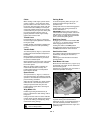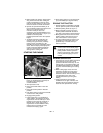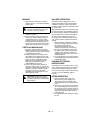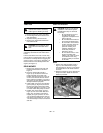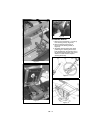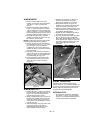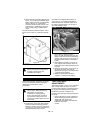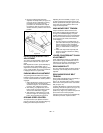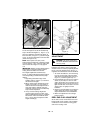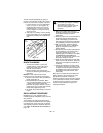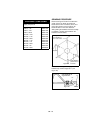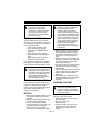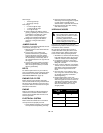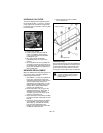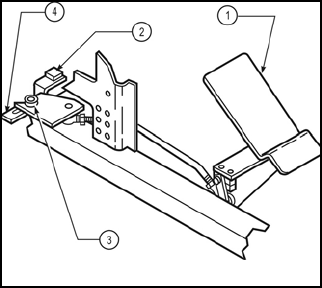
GB - 17
3. Once the traction pedal has been
adjusted, the safety switch (2, Figure 15)
may have to be re-adjusted by moving
the switch in the range of the slot
provided in the switch bracket. Adjust
the switch so that the engine cannot be
started unless the pedal is in the neutral
position.
UPPER COUNTERSHAFT BELT
ADJUSTMENT
The upper countershaft belt is driven by the
electric clutch located on the engine stub
shaft.
Belt adjustment is taken up automatically by
the torsion spring assisted idler arm; no
adjustment is necessary. If belt slippage does
occur, check the idler arm for free movement.
If slippage still occurs, replace belt.
PARKING BRAKE ADJUSTMENT
The parking brake should be set so that it
holds the tractor securely. The parking brake
must be released before the traction pedal is
engaged.
1. Adjust the brake by loosening set screw
in the brake knob and turning knob
clockwise to tighten, or counterclockwise
to loosen, then retighten set screw.
2. After making any adjustments, check
brake on flat ground so that the tractor
will not move with brake engaged.
3. Test further by putting tractor on a hill,
leave the engine on, and engage park
brake. Then test with the engine off.
GROUND SPEED CONTROL
The speed control (see Speed Control on
page 9) is meant to ease operator fatigue by
holding the forward speed constant.
Adjusting the hex head bolt (7, Figure 1) up
or down and locking it with the lock nut will
limit the pedal travel. Swing the speed control
away from the traction pedal to allow a full
range of forward speeds.
WING MOWER BELT TENSION
Proper belt tension allows mowers to be
driven without slippage but with belt loose
enough to be deflected slightly at a point
midway between pulleys. An overly tight belt
will cause excessive belt wear. Never allow
oil or grease to get on belt, which would
cause slipping.
1. The wing mowers must slide freely on
pull rods to allow the pull yoke springs to
properly tension the belt. If slippage
occurs, it could be due to a weakened
spring, a stretched belt, or sticky pull
rods.
2. Clean and oil pull rods frequently and
check to see that H-frames are sliding
freely on shafts.
LOWER COUNTERSHAFT CHAIN
ADJUSTMENTT
Chain adjustment is taken up automatically
by the torsion spring-assisted idler arm; no
adjustment is necessary. Periodically check
to see that the idler arm is free to pivot.
REAR MOWER LIFT
The rear mower lift height has been preset at
the factory and normally will not need to be
adjusted.
REAR MOWER DRIVE BELT
TENSION
Rear mower belt adjustment is provided by a
spring tensioned belt idler pulley (1,
Figure 16). The idler pulley must be pressing
down on the lower portion of the rear mower
belt (2, Figure 16).
If further adjustment is necessary due to belt
stretching, relocate the spacers (3, Figure 16)
on the pull rod pivot from position 3 to
position 4 (4, Figure 16), between the pull rod
pivot and the rear mower pull plate.
If proper tension cannot be accomplished by
the above procedure, replace the belt.
Figure 15



